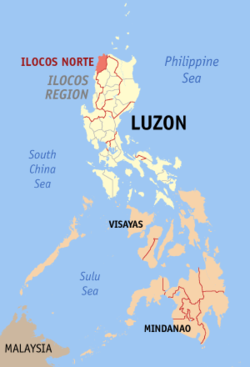Ilocos Norte
| Ilocos Norte | ||
|---|---|---|
| Province | ||
| Province of Ilocos Norte | ||

Ilocos Norte Provincial Capitol
|
||
|
||
 Location in the Philippines |
||
| Coordinates: 18°10′N 120°45′E / 18.17°N 120.75°ECoordinates: 18°10′N 120°45′E / 18.17°N 120.75°E | ||
| Country | Philippines | |
| Region | Ilocos Region (Region I) | |
| Founded | 1818 | |
| Capital | Laoag | |
| Government | ||
| • Type | Sangguniang Panlalawigan | |
| • Governor | Imee Marcos (NP) | |
| • Vice Governor | Angelo Barba (NP) | |
| Area | ||
| • Total | 3,467.89 km2 (1,338.96 sq mi) | |
| Area rank | 38th out of 81 | |
| Population (2015 census) | ||
| • Total | 593,081 | |
| • Rank | 48th out of 81 | |
| • Density | 170/km2 (440/sq mi) | |
| • Density rank | 52th out of 81 | |
| Divisions | ||
| • Independent cities | 0 | |
| • Component cities | ||
| • Municipalities | ||
| • Barangays | 557 | |
| • Districts | 1st and 2nd districts of Ilocos Norte | |
| Time zone | PHT (UTC+8) | |
| ZIP code | 2900–2922 | |
| IDD : area code | +63 (0)77 | |
| ISO 3166 code | PH-ILN | |
| Spoken languages | ||
| Website | www |
|
Ilocos Norte (Ilocano: Amianan nga Ilocos, Ilocos Norte, Filipino: Hilagang Ilocos) is a province of the Philippines located in the Ilocos Region. Its capital is Laoag City and is located at the northwest corner of Luzon Island, bordering Cagayan to the extreme northeast, Apayao to the east, and Abra to the southeast, and Ilocos Sur to the southwest. Ilocos Norte faces the South China Sea to the west and the Luzon Strait to the north.
Ilocos Norte is noted for being the birthplace of former President Ferdinand E. Marcos, who led an authoritarian rule over the country during the latter half of his incumbency. The Marcoses enjoy a modicum of popularity in the province. Ilocos Norte is also known as a northern tourist destination, being the location of Fort Ilocandia, an upper class hotel and beach resort famous among expatriates, and Pagudpud.
Long before the arrival of the Spaniards, there already existed an extensive region (consisting of the present provinces of Ilocos Norte, Ilocos Sur, Abra and La Union) renowned for its gold mines. Merchants from Japan and China would often visit the area to trade gold with beads, ceramics and silk. The inhabitants of the region, believed to be of Malay origin, called their place samtoy, from sao mi toy, which literally meant "our language here"
In 1571, when the Spanish conquistadors had Manila more or less under their control, they began looking for new sites to conquer. Miguel Lopez de Legazpi's grandson, Juan de Salcedo, volunteered to lead one of these expeditions. Together with 8 armed boats and 45 men, the 22-year-old voyager headed north. On June 13, 1572, Salcedo and his men landed in present-day Vigan and then proceeded towards Laoag, Currimao and Badoc. As they sailed along the coast, they were surprised to see numerous sheltered coves (looc) where the locals lived in harmony. As a result, they named the region Ylocos and its people Ylocanos.
...
Wikipedia

